Scientists have been looking for the reclusive neutron star expected to be at the center of supernova 1987A for over thirty years, and they may have finally found it in new images from the Chandra and NuSTAR observatories. Plus, a look at conflicting papers on the object that wiped out the dinosaurs, a roundup of news, and this week’s What’s Up.
Media
Transcript
Hello and welcome to the Daily Space. I am your host Dr. Pamela Gay.
And I am your host Beth Johnson.
And we are here to put science in your brain.
And to start things off, we’re going to show just how picturesque science can be. NASA’s Perseverance rover has released a color, 360-degree panorama of its landing site. Like all good phone-camera panoramas, things look pretty distorted in this rectangular view, but this does give us a hint of what’s to come. The camera that took this image, Mastcam-Z, can zoom, record video, and provide wide-angle and panorama shots like this one. We’ll have the link to the original in our show notes so you can zoom in and out yourself and really appreciate the scope of the image.

As awesome as it is to squee at the Martian landscape as Perseverance does its best imitation of Ansel Adams, there is science to discuss, people. There. Is. Science.
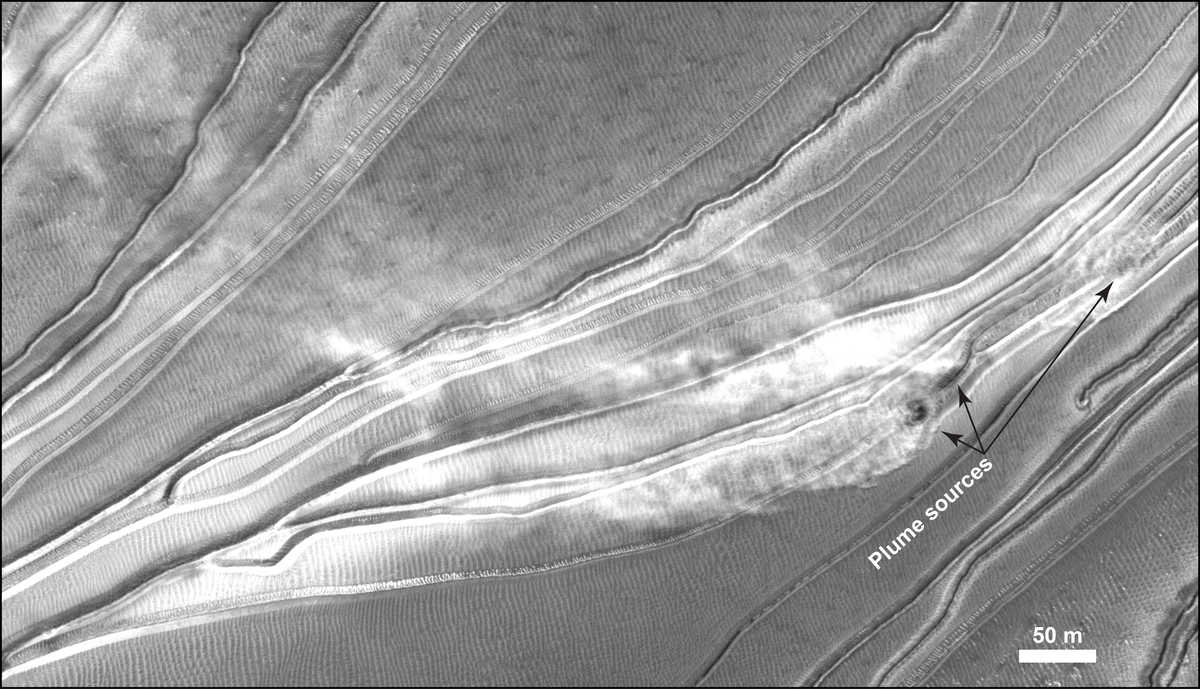
Researchers from the Southwest Research Institute have used eleven years of images from the Mars Reconnaissance Orbiter to track the seasonal activity on Martian sand dunes, tracking airborne dust plumes, and the emergence of linear gullies and they think they pieced together what is happening.
In a new paper in Geophysical Research Letters, Cynthia Dinwiddie and Timothy Titus explain that they often find chunks of dry ice at the base of the gullies, and they believe that spring heating can cause some carbon dioxide (CO2) to vent and also break off a chunk of dry ice that will slide down the gully, stirring up the dust plumes and carving the gully as it goes. According to Dinwiddie: For two decades, planetary scientists have had many ideas about how and when very long, narrow gullies formed on frost-affected sand dunes on Mars. Initially, scientists thought linear dune gullies were remnants of an ancient time when the climate on Mars supported liquid water on its surface. Then, repeat imaging showed that changes were happening now when Mars is cold and arid. Several hypotheses have since been proposed, usually involving either CO2 ice or water ice. In this paper, we offer compelling new evidence that venting CO2 gas dislodges CO2 ice blocks that carve and modify linear dune gullies.
And there you have it: Mars may not have flowing water, but it does have sliding ice.
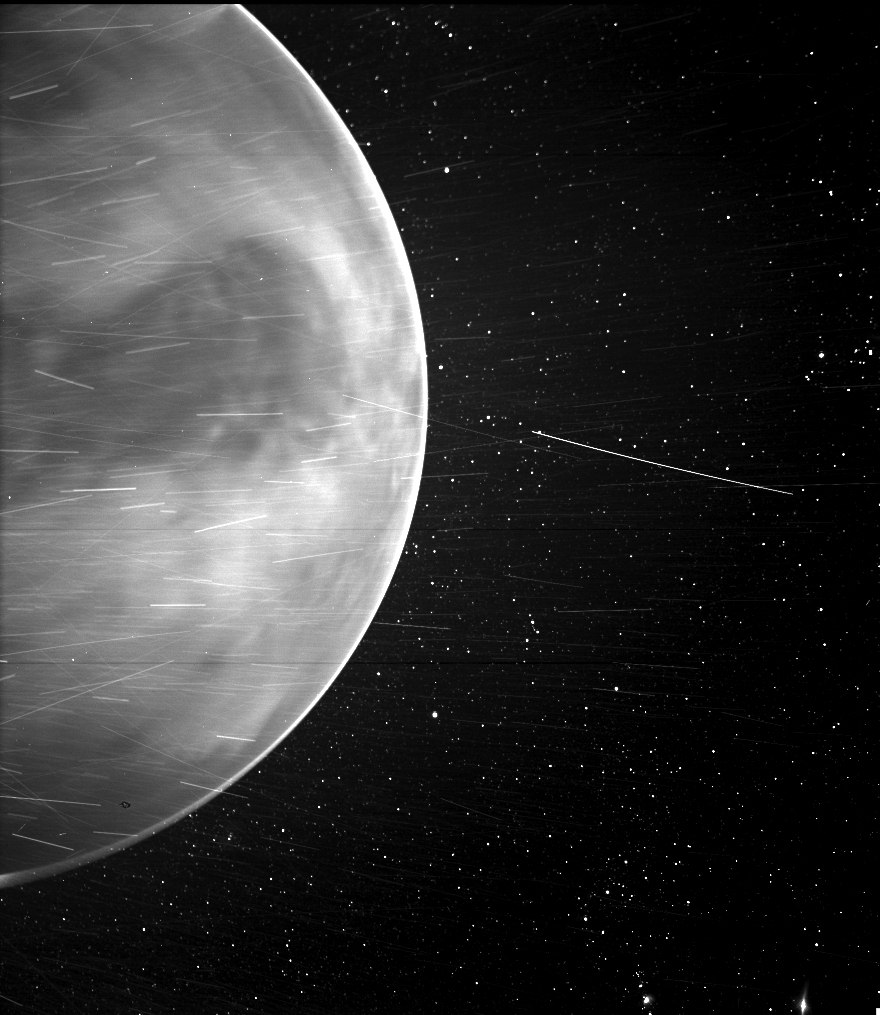
Believe it or not, Mars isn’t the only world with spacecraft. Venus not only has the orbiting Akatsuki mission but it also just got a fly-by from the Parker Solar Probe. This NASA mission uses the gravitational pull of Venus to adjust its orbit as it dives in and out of the Sun’s corona. Back in July, Parker captured this stunning image of the night side of Venus. Yes, the night side. It turns out, the camera they used is more sensitive to infrared light than anyone knew, and they were able to see the glow of warm clouds and the dark sweep of the cool Aphrodite Terra highland region. This was completely unexpected, and quite by accident, this team seems to have found a window through the Venusian atmosphere while just trying to get a picture of its glowing terminator, which they did get — that glow along the edge is the nightglow. Oh and that streak, it’s probably just a cosmic ray hitting the camera in a particularly artistic way.
Not all science gets to be pretty, but that doesn’t mean the results can’t still be awesome. As you may have heard last year, NASA released a set of Moon rocks collected by Apollo astronauts for new analysis. Today, we have new results from these old rocks.
In a paper published in Science Advances, Alberto Sall and Erik Hauri discuss the molecules found trapped in lunar volcanic glasses from the Apollo 15 and 17 missions. According to the release: This new study looked at 67 individual volcanic glass samples and their melt inclusions — tiny blobs of molten lava trapped within crystals inside the glass. Melt inclusions capture the lava before sulfur and other volatile elements are released as gas during eruption.
They found a variety of different ratios of sulfur isotopes, which implies different lava flows came from different reservoirs within the Moon. By understanding the history of the lava flows, we can now start to understand the history of the Moon’s interior too. There are still more samples to analyze, and we hope there will be more samples returned by future missions. This research is just beginning and we look forward to future results.
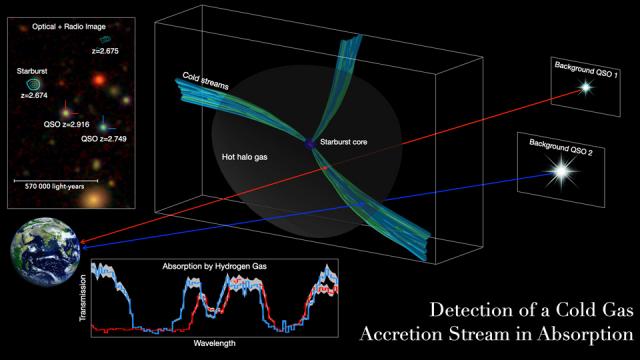
From planets and moons, we now jump wildly to the beginning of the universe. One of the more confusing things we’ve had to try and figure out in recent years is how massive galaxies with supermassive black holes were able to rapidly form close to the beginning time. The universe was pretty hot back then, and hot material tends to be fast-moving and not particularly likely to collapse down into stuff like galaxies and stars. A couple of decades ago it was theorized that cosmic filaments – cold channels through the chaos – could pour material into forming galaxies. While the theory made sense, no theory is to be believed until we have observational evidence, and now we have that evidence.
In a new paper in The Astrophysical Journal with lead author Hai Fu, researchers present observational evidence from ALMA of cold filaments channeling material into a massive galaxy. According to Fu: Based on our observations, such streams can fill up the reservoir in about a billion years, which is far shorter than the amount of time that was available to the galaxy at the epoch that we were observing.
These observations were only possible because there are two even more distant quasars shining light through the forming galaxy. Basically, we got lucky; from our perspective three massive galaxies formed in the same patch of sky within the first 2.5 billion years of the universe, and the two more distant galaxies allow us to see cold filaments in the nearer system. As Fu says: So, I feel extremely fortunate that nature provided us this opportunity to detect this major artery leading to the heart of a phenomenal galaxy during its adolescence.
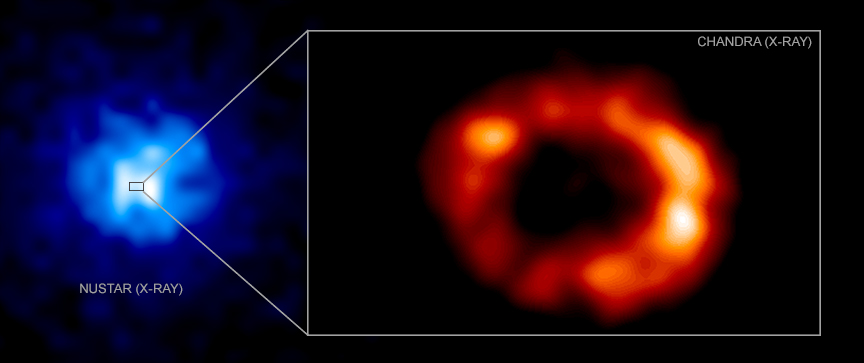
In theory, a supernova should go off in a galaxy like ours about every one hundred years. Frustratingly, we haven’t seen one in a lot longer than one hundred years. This could be because supernovae have been going off in hidden places, for instance on the other of the center of the galaxy or behind one of the dark molecular clouds where stars like to form. No matter what’s going on, a nearby supernova hasn’t been in our galaxy’s cards, and the best we have had is supernova 1987A in the nearby Large Magellanic Cloud, which is actually a galaxy imitating a cloud as seen from the southern hemisphere.
First appearing on February 24, 1987, astronomers have been able to track its evolution in glorious detail, and this year one particularly-looked-for detail has started to let itself be seen, sort of. SN1987A is the result of a massive star running out of fuel in its core. When this happened, the core collapsed, in theory, into a neutron star, and the outer layers bounced away to form the nebula we see today. The thing is that for the past 34 years, no one has been able to see a neutron star in this system. To be fair, it’s still a mess of gas and light and debris that we can’t see through with our telescopes. It’s expected that when we can clearly see that collapsed core, we’ll find it rapidly spinning like a pulsar. For now, though, we can’t see it directly, but using a suite of modern telescopes, a team has detected what appear to be the effects of a pulsar spinning in the middle of that mess.
This is pretty extraordinary. That spinning neutron star should be about ten miles across and have mass several times the mass of the Sun. We are literally looking for an object about the diameter of Manhattan that is located 168,000 light-years from Earth. Luckily, this small object can put on an amazing show.
This show, unfortunately, is in colors of light our eyes can’t see. This team looked at SN1987A in the X-ray with Chandra and NuSTAR and in longer wavelengths with ALMA. Their results, published in The Astrophysical Journal this week with lead author Emanuele Greco, show a mix of high energy X-rays, brightening radio emissions, and other behaviors consistent with a neutron star spinning in the center of the supernova remnant.
According to coauthor Marco Miceli: Astronomers have wondered if not enough time has passed for a pulsar to form, or even if SN 1987A created a black hole. This has been an ongoing mystery for a few decades and we are very excited to bring new information to the table with this result.
Alcatore Orlando adds: Being able to watch a pulsar essentially since its birth would be unprecedented. It might be a once-in-a-lifetime opportunity to study the development of a baby pulsar.
The birth and evolution of pulsars is something that occurs on human time scales. SN1987A is a Millennial, and it has been watched as it matures by the Boomer astronomers. By the time the Zoomers are running the astronomy community, that pulsar should be a lot easier to detect, and over the next several generations, astronomers on Earth will be able to watch the pulsar emerge from behind the spreading debris and even slowly change in its rotation rate. I fully expect our technology to advance in unimaginable ways over these generations, but even though our current data may be seen as primitive, it’s well-calibrated, accurate data, and this will be the first time we’ve been able to digitally measure a supernova, its central remnant, and how it all changes over time.
The closest we have to this is the 1604 explosion that formed the Crab Nebula. Described by the likes of Johannes Kepler and Johannes van Heeck, that event was documented with drawings and written comparisons of its brightness to that of other stars. While this data is awesome, and the nearness of the system allows us to readily measure its continued expansion, this isn’t the same.
I’m still holding out hope for a visible light supernova in our galaxy, but until that happens, we have SN1987A, and today, 34 years and one day after we first spotted it, we can say hello to the pulsar spinning in its core.
We’ve talked before about how advances are made in science one step at a time, with the work of a lot of different people. And sometimes, advances are made by asking “But couldn’t it be…” and waiting to see if you are right or wrong. This means that someone is always checking out weird alternatives, just to make sure the weird stuff, isn’t reality.
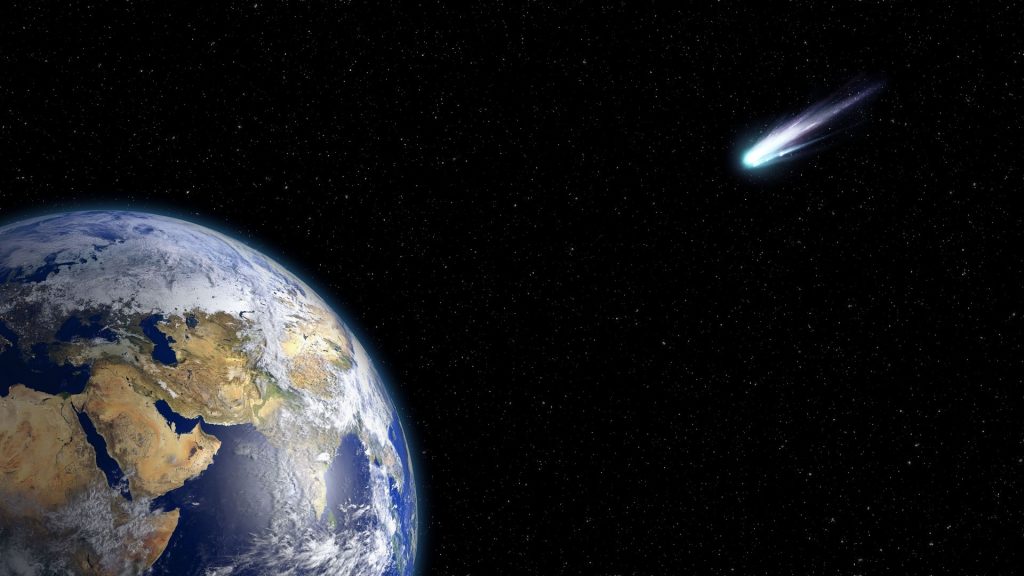
Such is the case with the object that ended the reign of the dinosaurs nearly 66 million years ago. What was it? We’ve been calling that seven-mile wide object an asteroid much of this time, but was it really? Could it have been a comet? That’s the hypothesis proposed in a paper published last week in Scientific Reports with lead author Amir Siraj, an undergraduate at Harvard University.
Siraj and his adviser used statistical analysis and gravitational simulations to calculate what fraction of long-period comets, those that originate from the far distant Oort cloud, are shifted off their original orbits by Jupiter’s gravitational field. This shift would make them swing into what we call a “sungrazing” orbit, passing very close to the sun. Close enough in fact to experience a tidal disruption event that breaks the comet into lots of smaller pieces.
And perhaps, some of the larger pieces could come back around and hit Earth on their new trajectories. The new calculations increased the chances of these impacts by a factor of ten from previous calculations, and show that about twenty percent of these long-period comets become sungrazers. This new rate of impact aligns with the 66 million-year age of the Chicxulub crater, which is the impact crater of our dinosaur-killer.
Additionally, there is evidence that the object was a carbonaceous chondrite in composition, which is rare for a main-belt asteroid but possibly common for a comet. The paper also cites several other large impact craters here on Earth that also match with the expected impact rate of sungrazing comets. More samples, particularly from those other craters and even comets themselves, are needed to confirm this hypothesis.
In the meantime, the other thing science is good at doing is rejecting alternative claims on the basis of stronger evidence. In a paper released just yesterday in Science Advances, a team of scientists published the results of their analysis of nearly 3,000 feet of rock core from the Chicxulub crater. They found conclusive evidence that the object that impacted Earth and wiped out the dinosaurs was an asteroid, based on the chemical fingerprint of the dust within the crater.

Per the press release: The telltale sign of asteroid dust is the element iridium – which is rare in the Earth’s crust, but present at elevated levels in certain types of asteroids. An iridium spike in the geologic layer found all over the world is how the asteroid hypothesis was born. In the new study, researchers found a similar spike in a section of rock pulled from the crater. In the crater, the sediment layer deposited in the days to years after the strike is so thick that scientists were able to precisely date the dust to a mere two decades after impact.
A layer of iridium dust is actually what kicked off the quest to understand what happened 66 million years ago. The layer is called the KT-boundary, and it can be found all over the world. In the 1980s, scientists analyzed the layer and found the iridium, and then the evidence began to pile up, culminating in the discovery of the Chicxulub crater in the 1990s. Chicxulub is a 125-mile-wide crater at the northern edge of the Yucatan peninsula. And now we know definitively that its age matches the time of the disappearance of dinosaurs in the global fossil record.
The team found that the concentrations of iridium were highest in a five-centimeter section of a core pulled from the top of the crater’s peak ring. This is where the rocks rebounded and then collapsed after the impact. You can search online for some amazing videos of simulations of the impact.
Also per the press release: In addition to iridium, the crater section showed elevated levels of other elements associated with asteroid material. The concentration and composition of these “asteroid elements” resembled measurements taken from the geologic layer at 52 sites around the world.
To sum up, a seven-mile-wide asteroid, not a comet, hit the Earth 66 million years ago in what is now known as the Chicxulub crater. The dust from the vaporized asteroid and rocks in the crater ended up in the atmosphere, circled the planet, blocked the sun, brought about a nuclear winter, and wiped out the dinosaurs along with about 75% of the rest of the plant and animal life on the planet. And mammals became the dominant species, so uh, thank you, asteroid?
What’s Up
This week, we have a full moon, and I have to admit, this is one of the four full moons of the year that I like to pay attention to. This is one of the full moons that rise during twilight and is pretty easy for a beginning photographer to photograph. At 3:17 am Eastern / 2:17 am Central, the Sun, the Earth, and the Moon will all occupy the same plane in the sky. I say ‘plane’ instead of ‘line’ because the Earth and the Moon aren’t lined up, and the Moon will be outside Earth’s shadow shining brightly in the Sun.
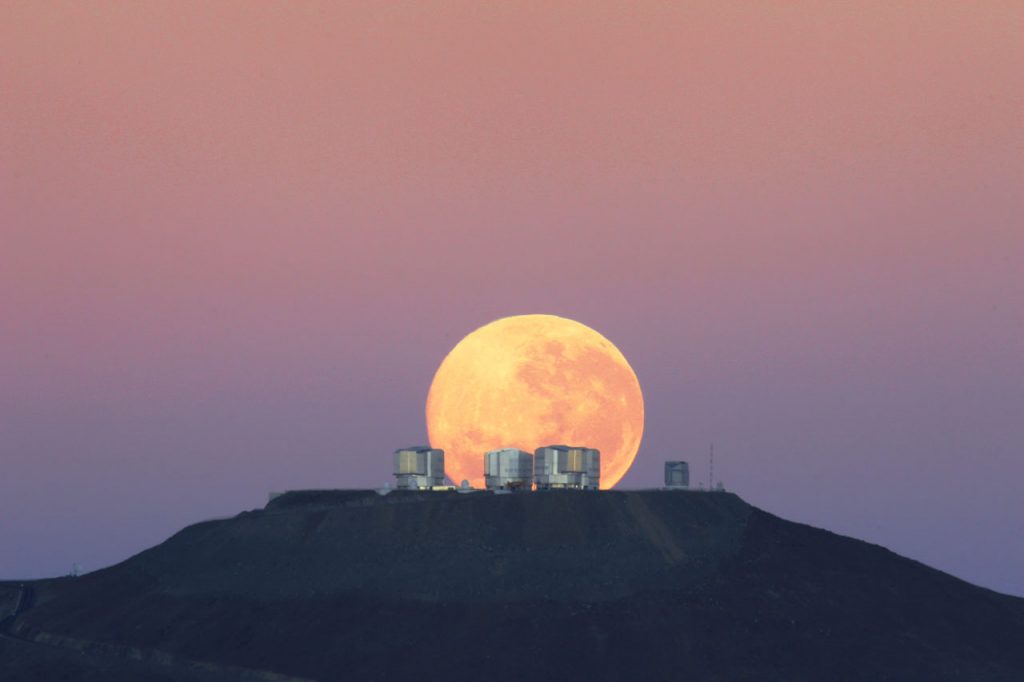
Our eyes, and for the most part our cameras, will see the Moon as full for all of tomorrow. Moonrise will be within a few minutes of sunset for mid-latitude locations in the U.S. and Europe. This means that if you go out to a nice flat area – a plowed farm or expansive golf course – you will see the Sun and Moon, setting and rising, in a parallel dance in the east and west. Not only is this stunning to see, but it also means the moon is rising in the twilight, and its bright disc will be easier to photograph against the still blue sky.
The Moon will also appear huge to the easily fooled human mind. When we see the Moon next to distant trees or buildings, our brain translates it as HUGE. The thing is, the Moon is actually the same size no matter where it is in the sky, and you can check it for yourself by comparing it to the size of your pinky nail, held at arm’s length when the moon is on the horizon and a few hours later when it is higher in the sky.
Now, I didn’t say exactly when sunset and moonrise will be because the exact numbers depend on your location within your timezone and your landscape. The website timeanddate.com has great tools for looking up this information as well as a lot of other facts about the sky and time itself. Check it out and make your plans to go out and watch the horizon.
If you want to try your hand at taking a spectacular moonrise photo, go out tonight and note where the Moon rises and figure out where you need to be to get the alignment you want. Mark the spot, and return there with a camera tomorrow. You’ll want to use your best telephoto lens to make the Moon as big as possible against a distant object. Tonight’s moonrise will be about 45 minutes earlier than tomorrow’s, but again, use something like timeanddate.com to get the exact times for your location.
If you do get a shot, please share it with us by tagging us on Twitter or Instagram. We’ll share the best photos during next Thursday’s What’s Up segment.
This has been the Daily Space.
Learn More
Scientist Finds Evidence of Seasonal Activity on Martian Sand Dune
- SwRI press release
- “Airborne Dust Plumes Lofted by Dislodged Ice Blocks at Russell Crater, Mars,” Cynthia L. Dinwiddie and Timothy N. Titus, 2021 February 24, Geophysical Research Letters
Parker Solar Probe Captures Stunning View of Venus
- NASA press release
Newly Released Apollo Moon Rock Samples Provide Composition Clues
- Brown University press release
- “Large sulfur isotope fractionation in lunar volcanic glasses reveals the magmatic differentiation and degassing of the Moon,” Alberto E. Saal and Erik H. Hauri, 2021 February 24, Science Advances
Cold Gas Pipelines Feed Early, Massive Galaxies
- University of Iowa press release
- “A Long Stream of Metal-poor Cool Gas around a Massive Starburst Galaxy at z = 2.67,” Hai Fu et al., 2021 February 24, The Astrophysical Journal
Neutron Star in SN1987A May Have Been Found
- Chandra X-ray Observatory press release
- “Indication of a Pulsar Wind Nebula in the hard X-ray emission from SN 1987A,” Emanuele Greco et al., to be published in The Astrophysical Journal (preprint on arxiv.org)
What Killed the Dinosaurs? An Asteroid or a Comet?
- Center for Astrophysics press release
- “Breakup of a long-period comet as the origin of the dinosaur extinction,” Amir Siraj and Abraham Loeb, 2021 February 15, Scientific Reports
- The University of Texas at Austin press release
- “Globally distributed iridium layer preserved within the Chicxulub impact structure,” Steven Goderis et al., 2021 February 24, Science Advances
What’s Up: Full Snow Moon on February 26
- Sky & Telescope article
- EarthSky article
- Full Moon – the Moonlight Phase (timeanddate.com)
Credits
Written by Pamela Gay and Beth Johnson
Hosted by Pamela Gay and Beth Johnson
Audio and Video Editing by Ally Pelphrey
Content Editing by Beth Johnson
Intro and Outro music by Kevin MacLeod, https://incompetech.com/music/


 We record most shows live, on Twitch. Follow us today to get alerts when we go live.
We record most shows live, on Twitch. Follow us today to get alerts when we go live.
Great podcast episode as always. I did note a minor error. The Crab Nebula supernova occurred in 1054 not 1604 as stated. The 1604 supernova was located in Ophiuchus and is known Kepler’s supernova.
I’m old enough and located in Australia to have visually observed the 1987A supernova (the day after it occurred)!